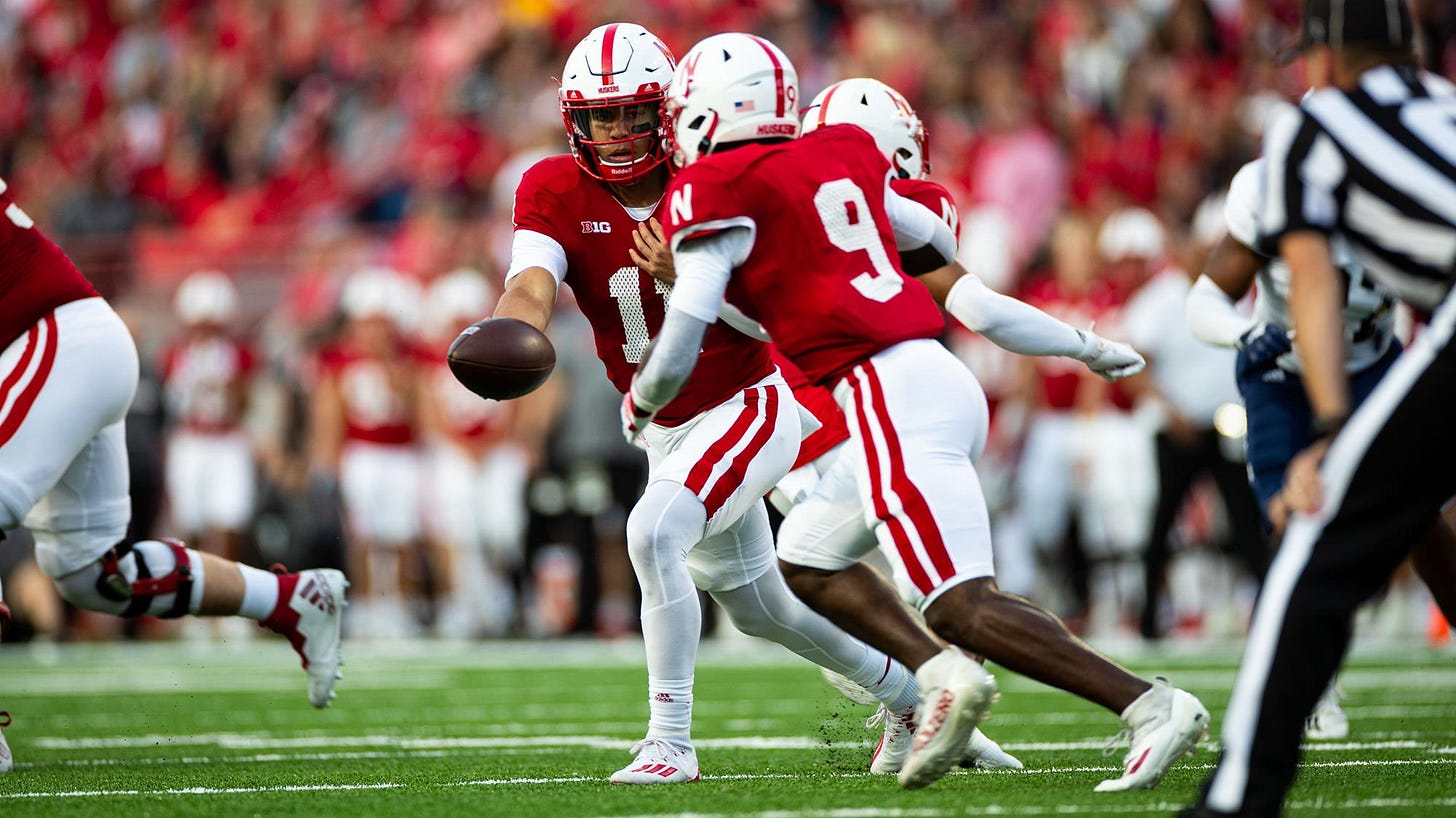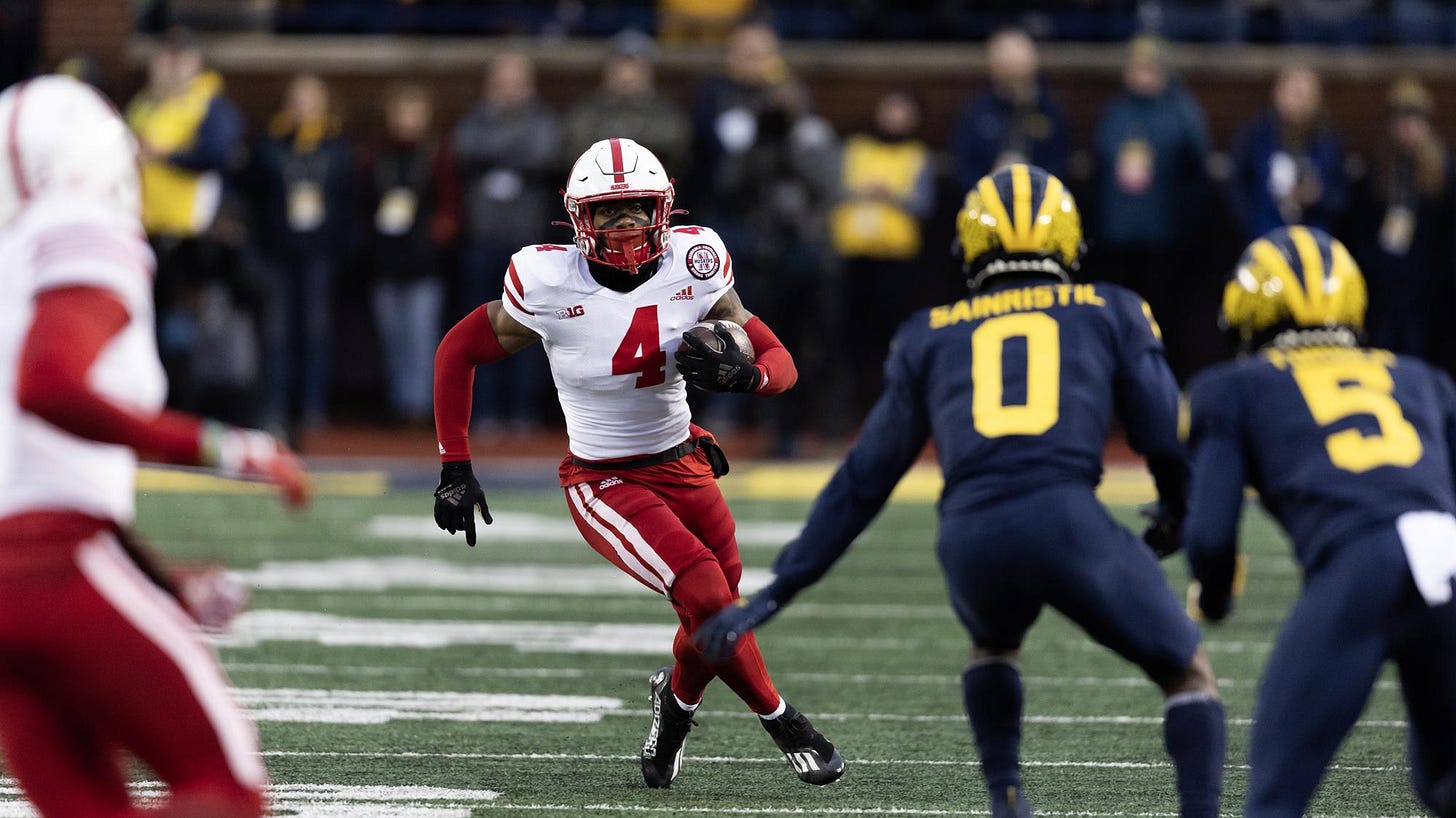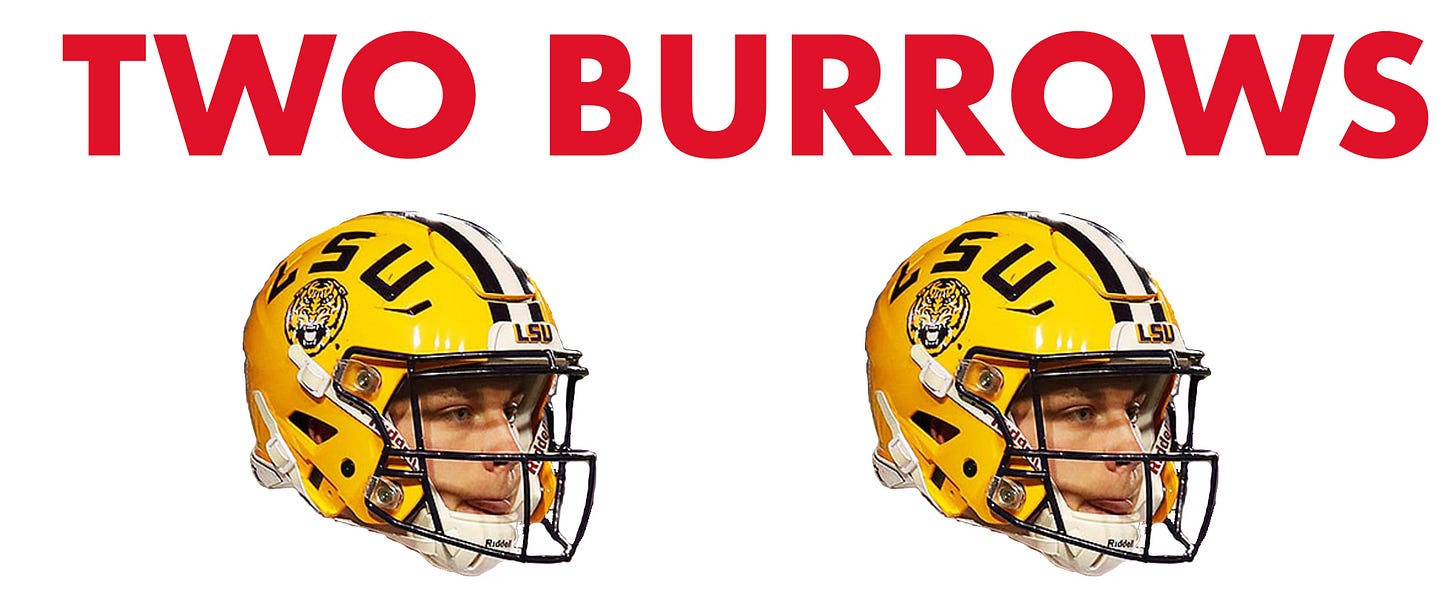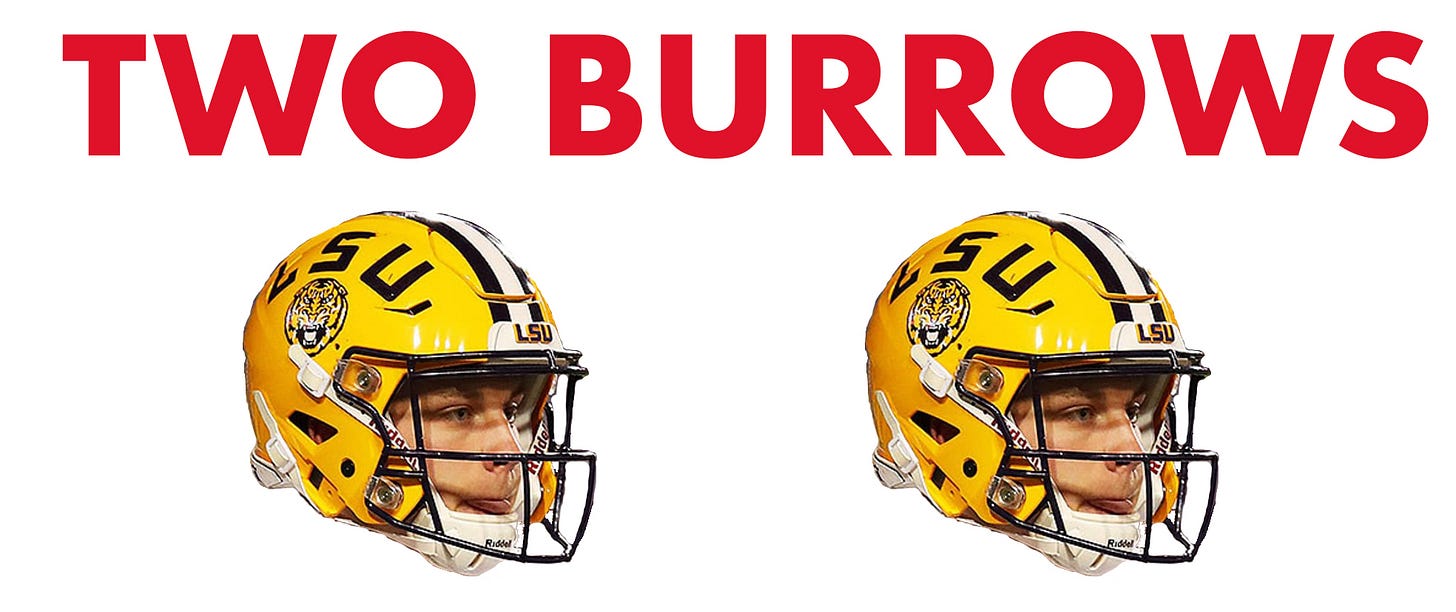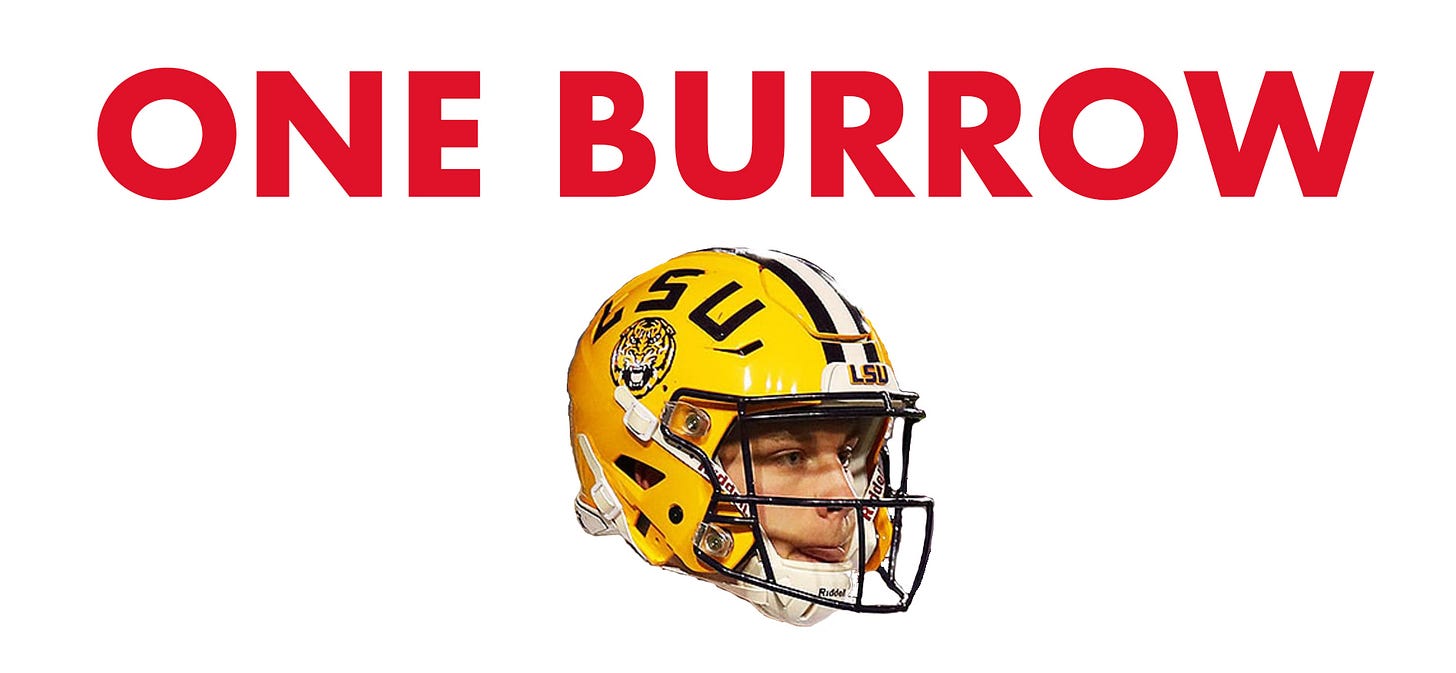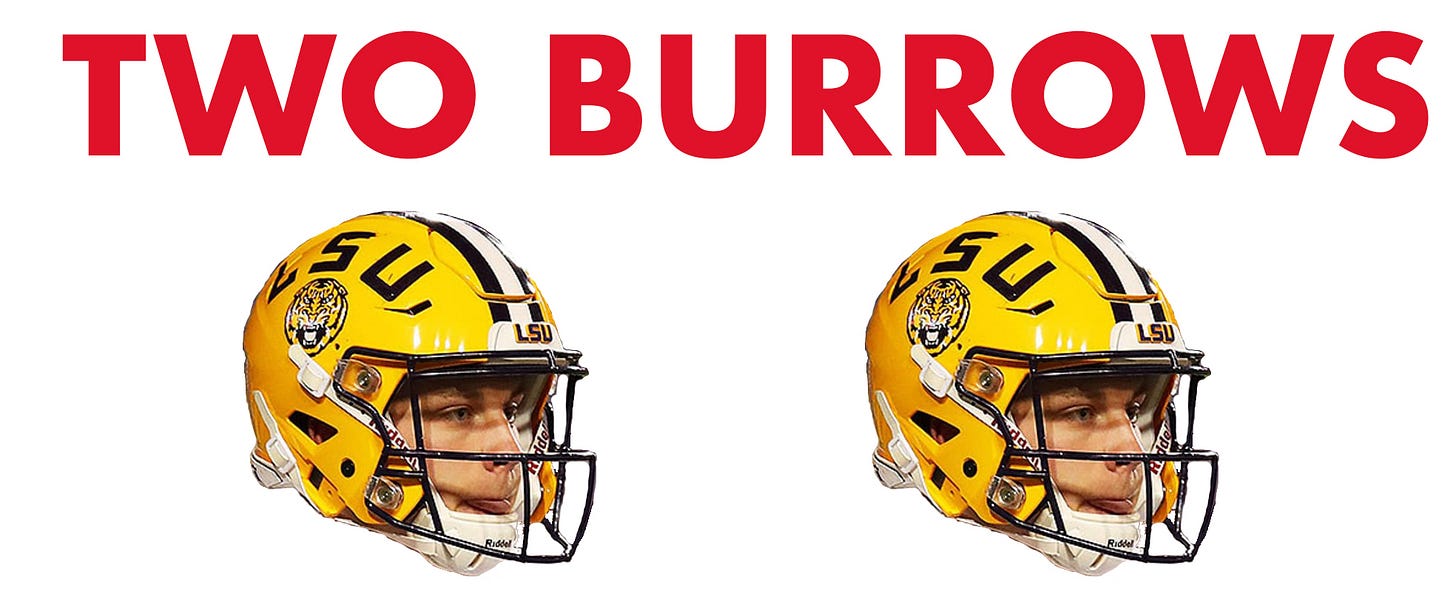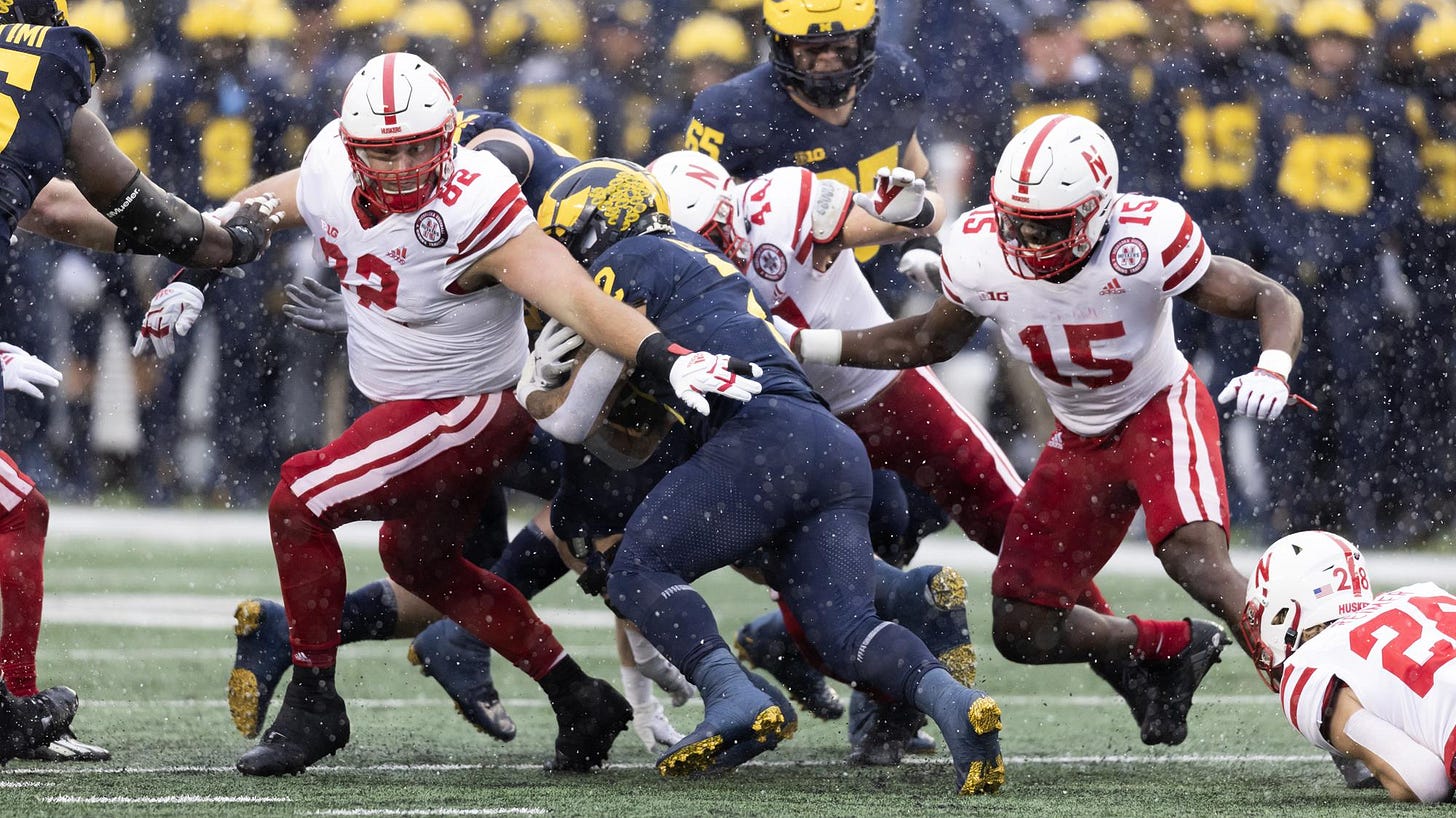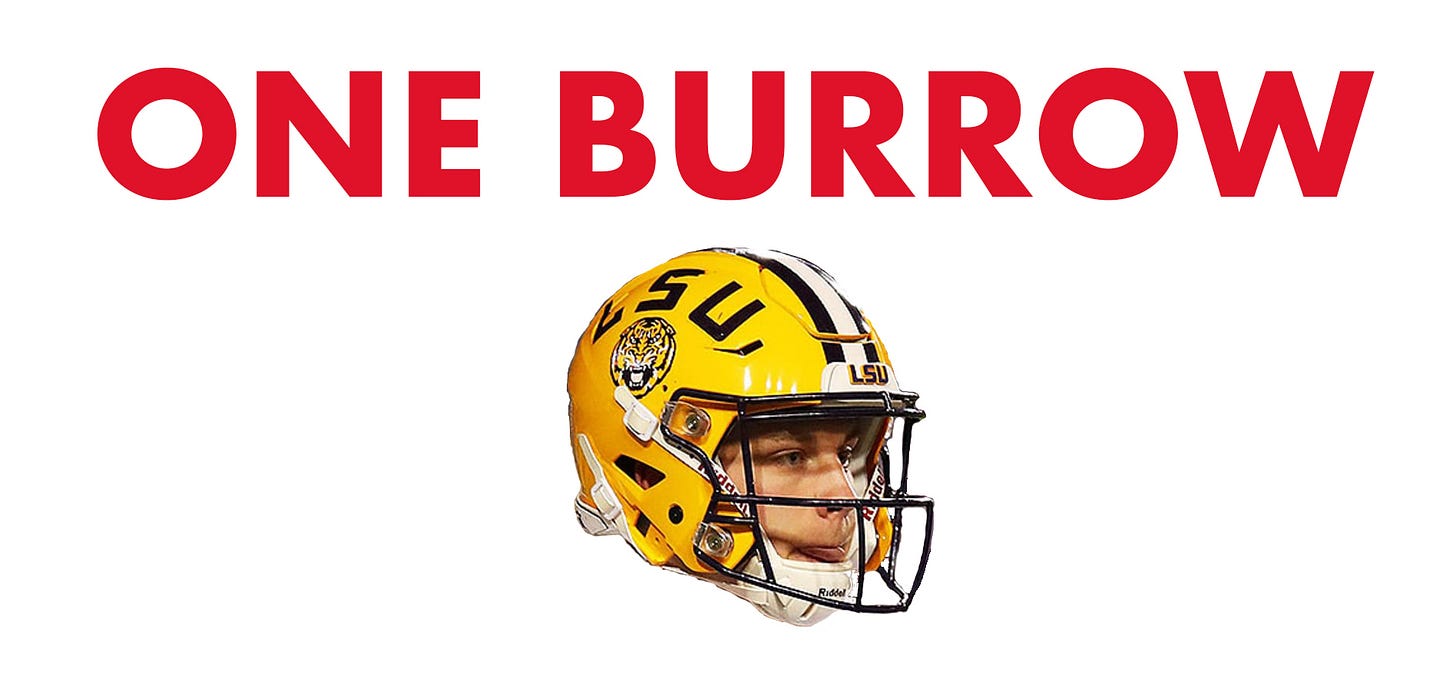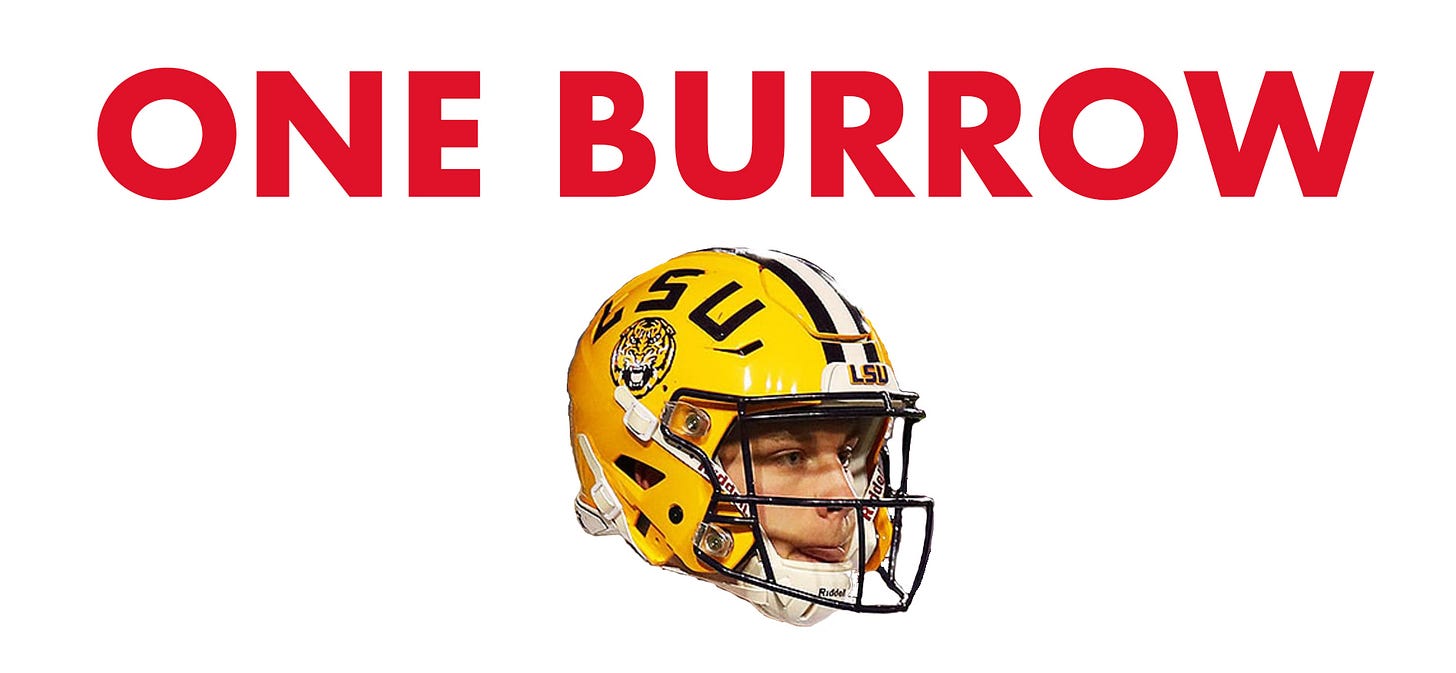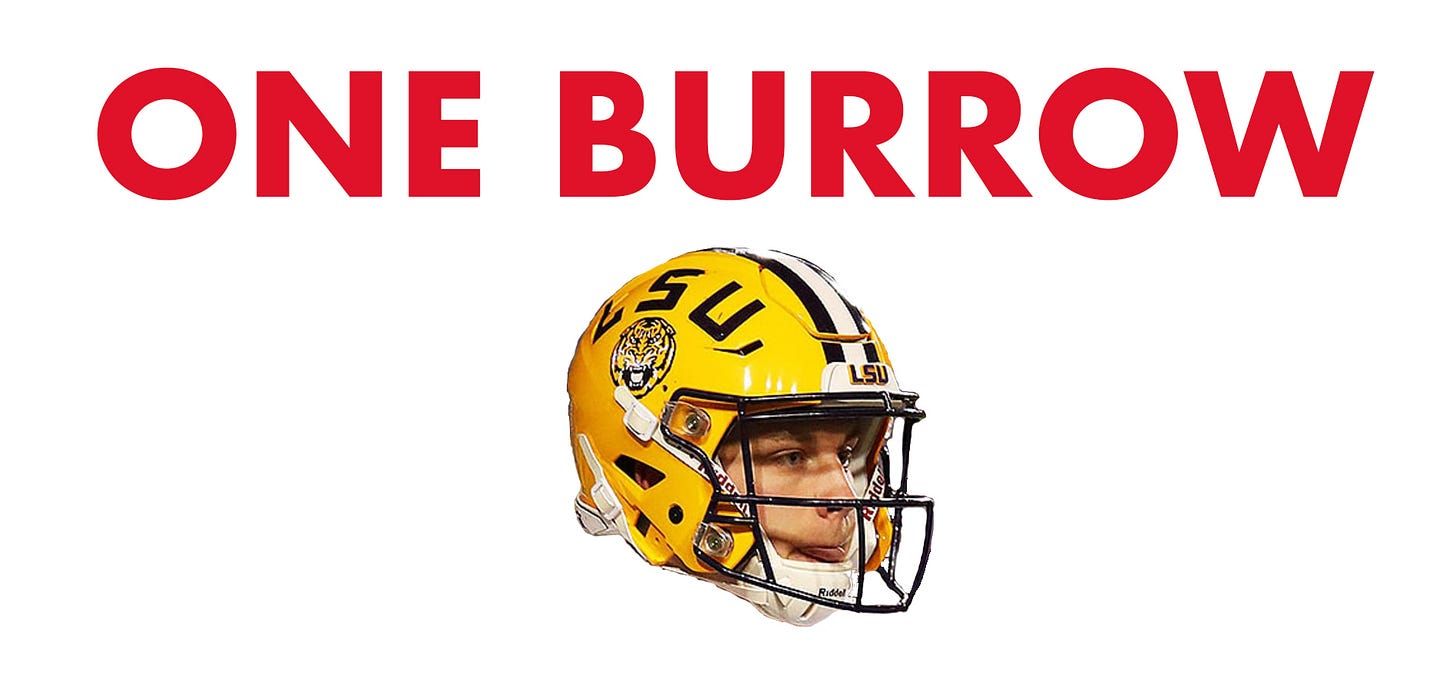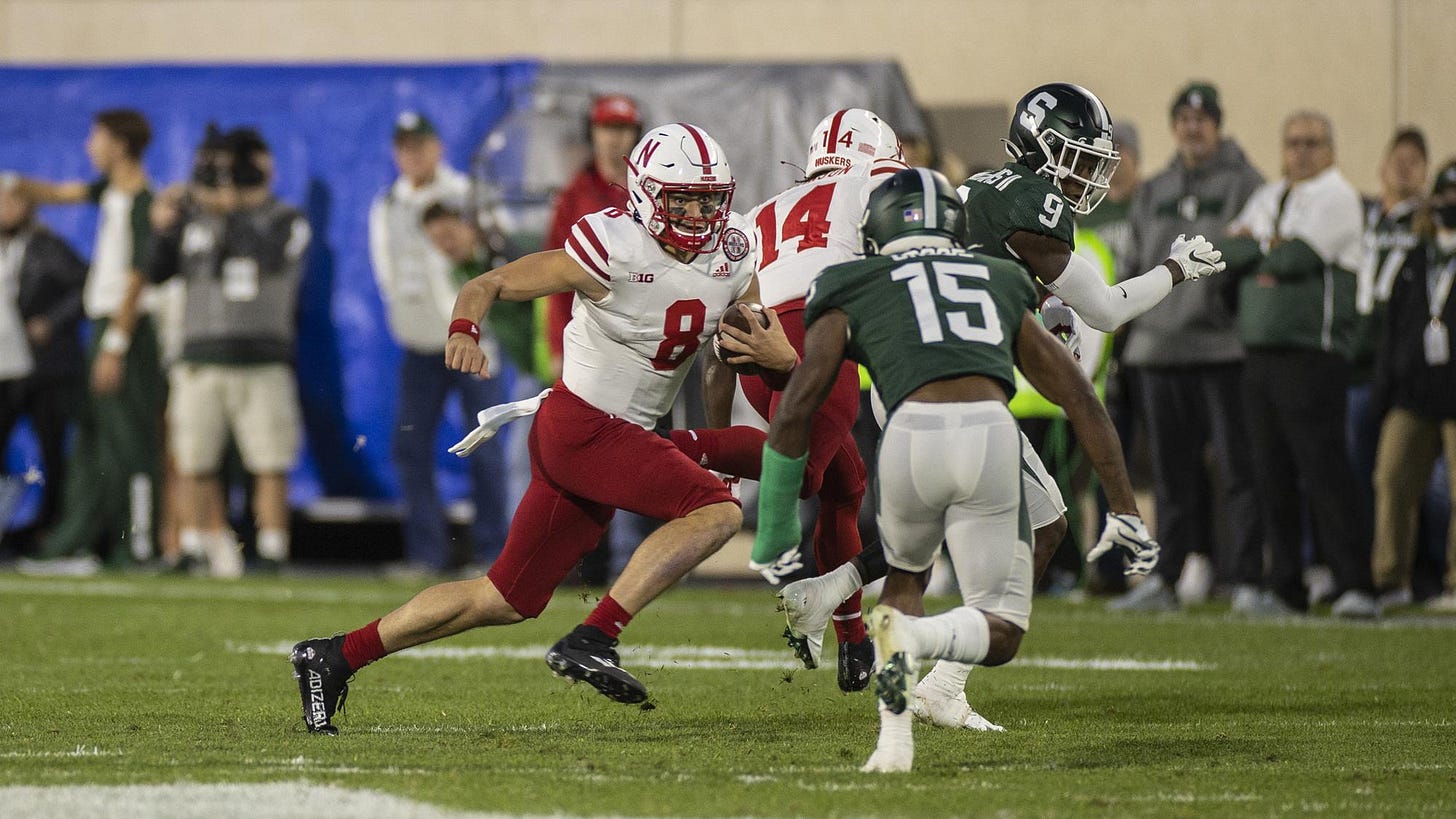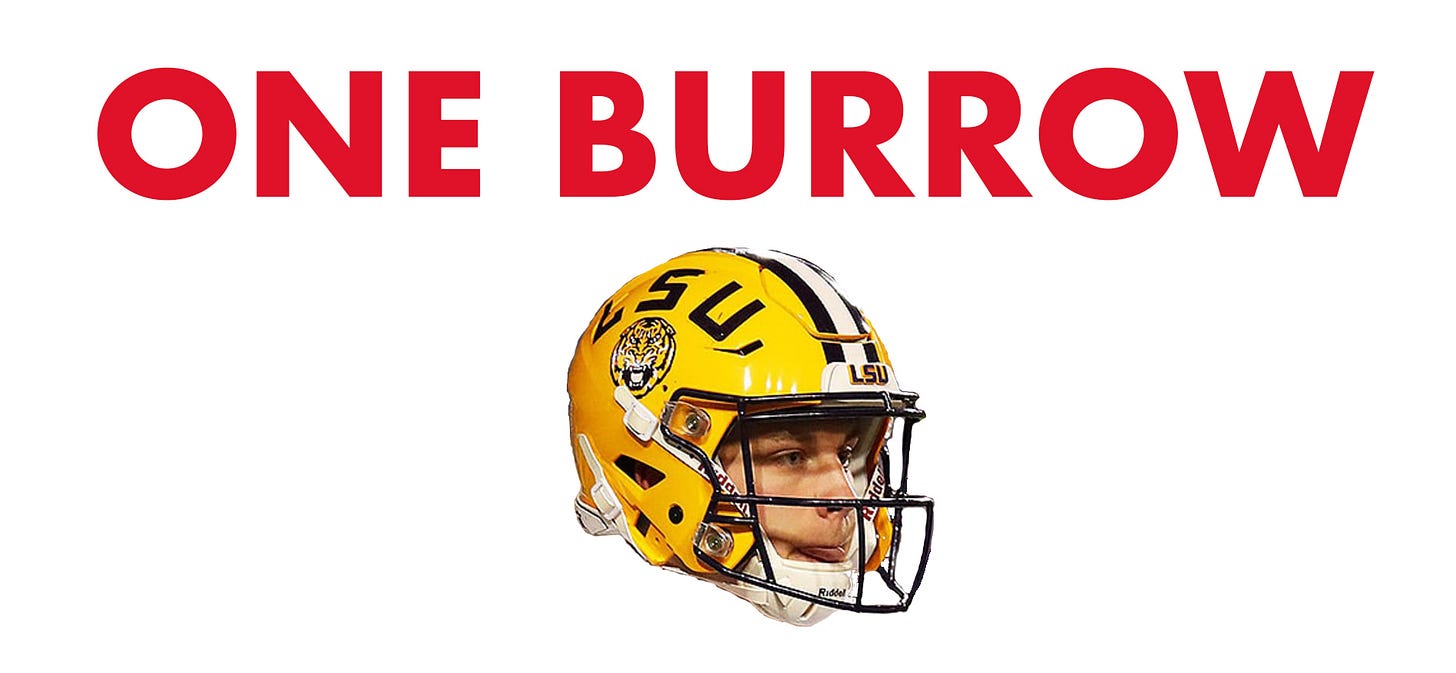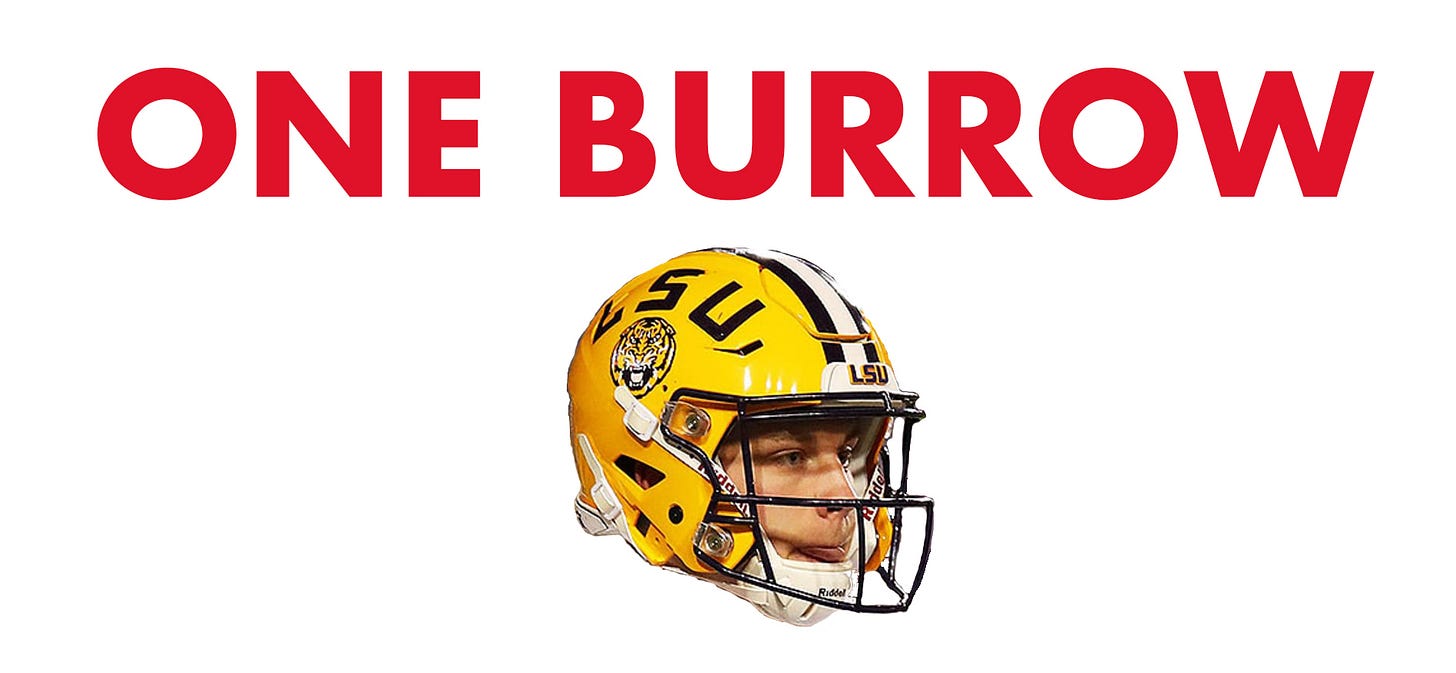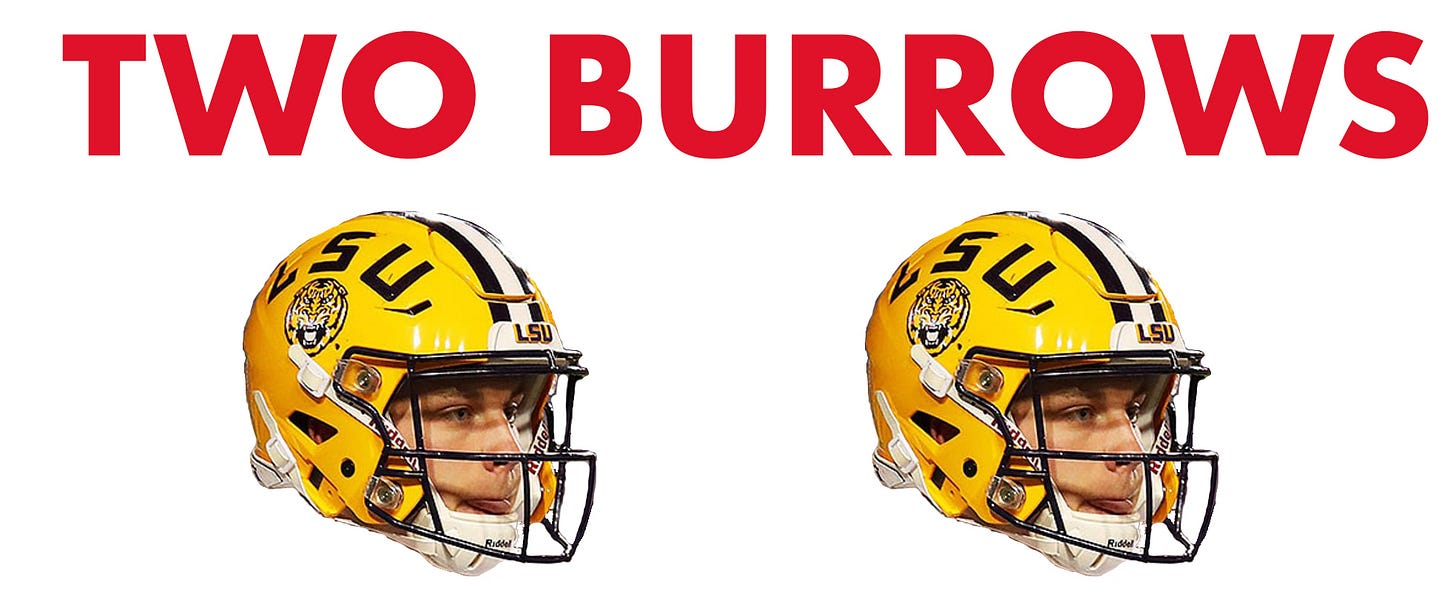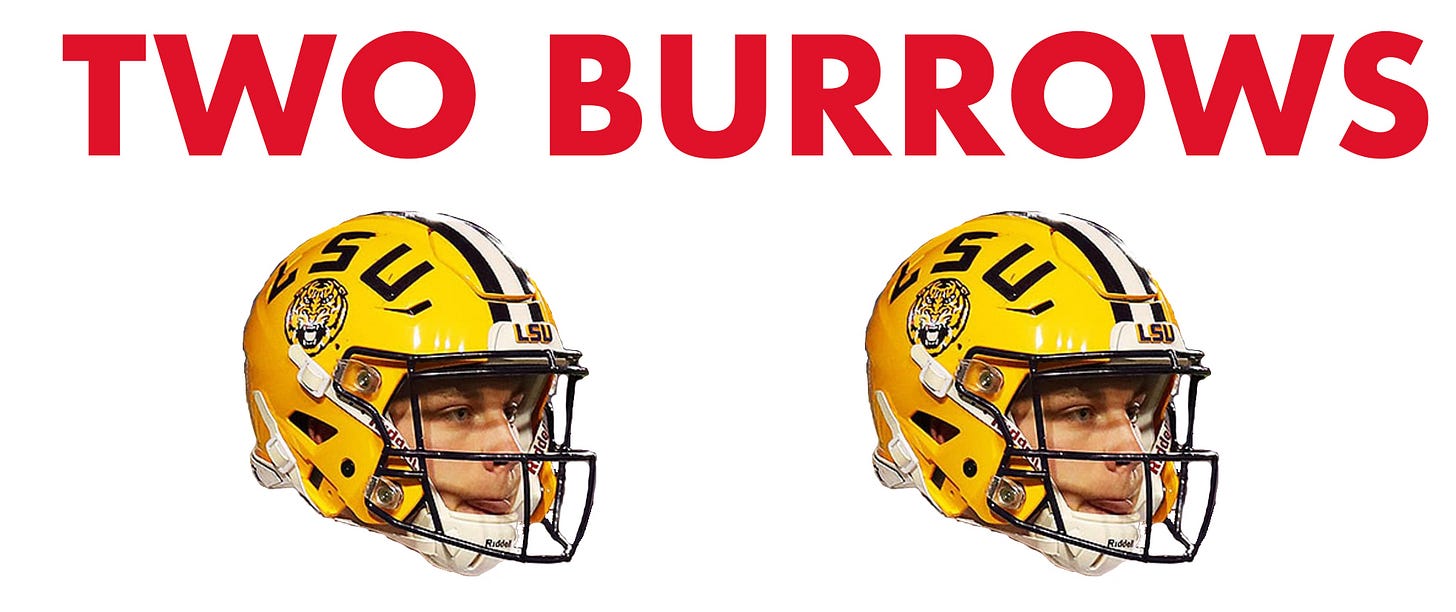I Think You Should (Maybe Not) Leave
Part One of a deep dive into the transfer portal's impact on Nebraska's roster: Departures Edition
In just a handful of years, the easing of restrictions on transfers has radically changed how college football teams are constructed and maintained. The NCAA began loosening the reins in 2018 with several rules to give players more latitude in where they chose to play, but the floodgates opened in earnest with the 2021 decision to grant first-time transfers immediate eligibility at their new schools.1 In those few years, we’ve mostly just seen the elite of the sport consolidate even more of the talent while shedding even more of their dead weight, but we’ve also been provided several examples of how nailing one transfer cycle can skyrocket a team from mediocrity into playoff contention: most notably, Michigan State and Tennessee in 2022 and TCU and USC last year.
It’s also been a sea change for new coaches, who no longer are stuck inheriting a largely static team for their first season and can kick-start rebuilds by replacing large swaths of the roster in a few weeks. While new Nebraska coach Matt Rhule hasn’t overseen quite the exodus that new Colorado coach Deion Sanders has, 25 players have left the program since his hiring, among the tops in the nation. That level of attrition seems concerning on the surface, but it’s more likely just the new normal in the sport for first-year coaches.
But that doesn’t mean everyone who hit the bricks was a roster-rebuild casualty: Some of the losses were productive, young players I’m sure the new staff wanted to keep. In an effort to analyze which of the departures will be missed and which probably won’t, I’ve dug into each player’s statistical profile and tried to rank the potential impact of their loss. I’ve rated each player on a 1 to 5 scale in honor of Nebraska’s most infamous transfer portal mistake: A rating of FIVE BURROWS means the player has the ceiling of being a potential all-conference or even All-America selection, while a rating of ONE or ZERO BURROWS means their loss will probably be immaterial.
One quick disclaimer before we start: I am very loath to criticize 18- to 21-year-olds in general, but I am especially very loath to criticize 18- to 21-year-olds who dedicate the level of work and time into their crafts that being a major college football player requires and who often see their success or failure determined by factors outside of their control. There are dozens of reasons why a player can be successful or unsuccessful at any particular program: poor coaching, injuries, or just plain bad luck. These ratings are purely a, “I have my objective analysis hat on” as opposed to any statement on their quality as people or work ethic or whatever nonsense. Carry on.
Ajay Allen, Running Back
Allen was a late addition to the 2022 recruiting class, signing with NU after decommiting from TCU in part to follow then-new running backs coach Bryan Applewhite. In a deep running back room, Allen shot up the depth chart after arriving in May and was serving as the No. 2 back by Game One. After carrying the ball three times for 7 yards in the opener against Northwestern, he got 31 touches over the next three games, turning it into 192 yards before suffering a season-ending injury against Oklahoma and redshirting. He announced his return under the new staff and went through spring practice but looked to be behind several other backs in the spring game and had a costly fumble that was criticized by Rhule. He was the last player to jump in the portal and signed with Miami soon after.
His surface-level play was good — 5.8 yards per carry, showcasing speed and vision on several long runs — but the underlying stats in a small sample size pointed to a player with an even higher ceiling. In his 30 combined rushes against North Dakota, Georgia Southern, and Oklahoma, Allen was credited with forcing 11 missed tackles and gaining 103 yards after he was initially contacted by a defender. This means, essentially, Allen was making a defender miss once every third time he touched the ball and he was gaining NU an extra 3.43 yards per carry beyond what the line had blocked for him. For context, Nebraska’s other four main backs forced a missed tackle about once every 4.5 carries, gaining just 2.56 yards after first contact. Allen’s isolated ability as a runner gained nearly a whole yard per carry more than any other Husker back, as a true freshman, and would have been 18th nationally over a full season, ahead of players like Blake Corum, Devin Neal, and Braelon Allen. Ajay Allen was also Nebraska’s most efficient big-play threat on the ground, running for seven 10+ yard gains in his 30 carries; NU’s other backs had just 29 such runs in 277 attempts.
He didn’t do his damage just as a speed merchant outrunning people to the edge, either, with his 16 carries in the A or B gaps (the gaps between the center-guards and guards-tackles) going for 6.18 yards per carry and accounting for 5 of his 7 runs of 10 yards or more. His tape shows good initial vision on Inside Zone and Duo plays, with the strength to get through the line of scrimmage and the speed to hit a crease into the secondary.
Some of his efficiency can be credited to the competition; NU faced five of the nation’s top rushing defenses later in the season when it got into Big Ten play. And we never really saw Allen’s ability as a pass-catcher; he got just two targets in his four games, catching one. But Allen at least showed the capability of being a starting caliber Big Ten back as a true freshman, one capable of creating on his own the chunk gains that have become the main role of the running game in modern football. Nebraska has a well-stocked running back room currently, but no one with the ceiling to grow into an all-conference or even All-America performer as an upperclassmen like Allen did.
Brant Banks, Offensive Tackle
Banks came to Nebraska as part of the 2019 five-lineman recruiting class that was supposed to rebuild The Pipeline, which didn’t really work out for him or anyone else. Banks was a huge, long, and skinny developmental prospect upon arrival and spent his first year redshirting without playing while putting on weight. He served as a reserve linemen and on special teams during the COVID season, then became NU’s primary swing tackle the past two years. With Bryce Benhart, Turner Corcoran, and Teddy Prochazka seemingly entrenched as Nebraska’s top tackles and all younger or the same age as Banks, he elected to transfer just after the season and ended up at Rice shortly after.
Some of Banks’ reps in pass pro have been aesthetically pretty ugly — something that can also be said of all NU tackles over the last few years — and he probably hasn’t played well enough to be a starter in the Big Ten, but he’s still been a useful player for Nebraska over the last two years. He’s seen about 50 snaps as NU’s top reserve tackle in each of 2021 and 2022 and performed as an average run blocker who showed major improvement in pass pro last year. Per PFF data, Banks didn’t allow a pressure or hit on the quarterback last year in 18 pass block snaps at tackle, 16 of which were true dropbacks where the defense had a real chance to pass rush, a big improvement on his 2021 numbers (1 hit, two hurries, and three pressures in a similar amount of dropbacks).
Most of Banks’ run last year came against Indiana, a team with a poor pass rush, and he didn’t seem to be able to move well enough to hold up against elite rushers he was seeing in the Big Ten. Still, almost every team has to tap into its offensive line depth at some point in a season, so losing a decent fill-in option does hurt, even if you can’t really blame him for chasing a starting job.
Marquis Black, Defensive Line
Black committed to Nebraska as part of the pandemic 2020 class as one of its lowest-rated signees. After not playing during a COVID-redshirt year, Black logged four total snaps during garbage time against Fordham, recording no stats as he redshirted again. He didn’t play at all last year as a third-year player on a team desperate for help at his position and transferred soon after the season, landing at Conference USA Western Kentucky. He probably just never belonged at the Power 5 level and can hopefully find success with the Hilltoppers.
Alante Brown, Wide Receiver
A high school star at Simeon in Chicago and one of the last additions to the 2020 recruiting class, Brown signed with the Huskers as a four star after decommitting from Texas Tech in the 2019 class and spending a year at prep school. He played immediately, appearing in every game of the COVID season, primarily as a kick returner but also getting some run as a gadget player on jet sweeps, reverses, and screens. He played a similar role in 2021 before breaking out last offseason and serving as NU’s starting Z in 2022. With Trey Palmer and Marcus Washington siphoning away most of the targets and a deep receiver room to contend with, Brown only finished with 191 receiving yards. He was slated to possibly be NU’s top returning receiving threat but didn’t appear to jive with the new staff and was away from the team during spring practice, eventually entering the portal in April. He was scooped up by Michigan State soon after.
Brown saw a huge increase in role last year, playing 410 offensive snaps after seeing the field for about 200 combined in his COVID and true freshman seasons. That didn’t manifest in impressive counting stats production, but there were some signs of improvement had he been given a larger sample size.
His biggest boost as a sophomore was just that when he got the ball, he almost always did something with it. Brown had 16 catches last year but turned 10 into first downs, meaning that almost 65% of the time he got the ball, Brown was moving the chains for NU. That was the second-highest rate of any receiver on the team, with Washington slightly ahead at 67%, Palmer at 56%, and Oliver Martin at 41%. Brown was also far-and-away NU’s most dangerous receiver with the ball in his hands, forcing nine missed tackles in his 16 receptions (.56 missed tackles per reception), with no other pass catcher on the team being above .27 missed tackles per reception.2 He also had zero drops in his Husker career on clean-catch opportunities; Palmer had 10 last season alone. Brown also blocked with effort in the running game and on screens and seemed to be our most physical and effortful perimeter blocker by my eyes.3
There were some mid signs with his game last year, though, too. Brown got 25 targets last year, converting them into catches 64.0% of the time, on-par with Palmer (64.5%) and Washington (64.6%). But those two were catching the ball much further down the field than Brown was, with Palmer’s and Washington’s average depth of target a full five yards longer down the field that Brown’s 8.6 ADOT. That number actually decreased from the previous year, when he was in the gadget role. It’s tougher to consistently complete a pass the further you throw it down the field, so that Brown wasn’t either (A) catching the ball further down the field in his expanded role or (B) catching more of his targets than the other two should be very concerning. Brown also had a truly atrocious Yards Per Route Run, generally considered the most holistic metric of how effective a receiver is: When they send you out to run a route, how often are you converting it into useful yards for the offense? Brown was at .92, with Palmer at 3.26, Washington at 1.61, tight end Travis Vokolek at 1.05, Martin at 1.39, and even Isaiah Garcia-Castaneda at 2.26. The only people who had worse Y/RR than Brown last year were running back Anthony Grant and No. 2 tight end Chancellor Brewington, both of whom were primarily check down and screen merchants.
Still, even if he is never going to be some down-the-field, ball-winning X, Brown was a starting-caliber Big Ten outside receiver who caught the ball when it was thrown to him, was dangerous in space and working laterally, and had improved his game every year. We already know he’s a valuable piece in the short and intermediate areas of the field on crossing routes and a good blocker, and he’s probably got more room to grow as a down-the-field threat. Even if he doesn’t start winning more past 10 yards, every healthy passing game needs those complementary, flanker-esque players to serve as No. 2 and No. 3 options. Brown was, at-worst, that, which is a loss.
James Carnie, Tight End
Carnie was an in-state recruit from Norris in the 2021 class who received little interest from Nebraska until he got an offer from Iowa, at which point the Husker staff put on the full-press and secured his commitment. He played in two games while redshirting that year, logging three snaps in the blowouts over Fordham and Buffalo where he run-blocked. But he didn’t log a snap last year, in a season where NU needed to tap into its tight end depth after injuries to Vokolek and Thomas Fidone. Rhule said Carnie wasn’t practicing in the spring, but he didn’t officially enter the portal until late April and as of writing hasn’t landed with a new school. Carnie was a great athlete in high school — running the 100-, 200-, and 400-meters in track — valuable for a player who is 6’5 and 225 pounds. Tight end is arguably the most difficult position in football to adjust to when you go up a higher level, with players needing to not only adapt to facing better coverage but having to contend with blocking bigger, stronger, faster bodies on the defensive line. It can be a difficult and long transition in college or the NFL. I have to imagine Carnie’s skillset would be useful to a Power 5 program, and that there’s quite a bit of untapped potential in a player who has yet to run a route in a game in college. I would not be surprised to see him have a productive career elsewhere, even at the P5 level.
Braxton Clark, Cornerback
The 6’4, long and lanky Clark was a member of NU’s first class under new coach Scott Frost and started playing as a depth corner right away, appearing in the maximum four games while redshirting in 2018 and playing 127 snaps in 2019 with one start. He missed all of 2020 with a camp injury but returned to his role in 2021. He competed for the starting corner job vacated by Cam Taylor-Britt in 2022 but lost out to Tommi Hill and later true freshman Malcolm Hartzog, appearing in just five games with poor play. He participated in spring practice but left soon after to find a new spot to spend his final two years and has yet to find a new program.
Losing experience in the secondary is never good, and Clark could have been a valuable depth piece, but he’s never been a particularly good corner at the Big Ten level. In 26 career targets by opposing quarterbacks, Clark has allowed 20 completions, a 76.9% completion rate against. For context, NU’s two starting corners, Quinton Newsome and Hartzog, allowed conversion rates of 52.8% and 50.0% on 72 and 32 targets last year, respectively. Allowing completions is OK if you’re providing disruption, but Clark wasn’t really doing that, either, with just two pass-break-ups and one pick in his career. Clark is great at preventing big plays — he has a career 9.4 yards per completion against and never allowed a completion longer than 20 yards — but his height limits his side-to-side and stop-start mobility, making it easy for offenses to take advantage of him with lateral and quick-hitting routes. He will probably be more successful at a lower level where he’s facing fewer athletes who can take advantage of that.
Decoldest Crawford, Wide Receiver
Crawford was one of Mickey Joseph’s recruiting coups after joining the staff just before early signing day for the 2022 class. Crawford was a consensus three-star recruit but had decommited from home-state LSU and also was pursued by Texas, Florida, and Auburn after re-opening his recruitment, so there’s maybe more talent there than the recruiting services are crediting him with. Crawford was getting some camp buzz last season as a potential contributor in the slot but suffered a major knee injury in a scrimmage that led to a redshirt and rehab year. He entered the portal only a few days after the season ended and landed at Louisiana Tech. His high school tape shows a lanky, rangy receiver with speed and ability to make plays downfield, which is never good to lose, but he surprisingly didn’t appear to generate much, if any, Power 5 interest in the portal. His brief Husker career will likely be best remembered for him cutting one of the funniest deals in the nascent NIL marketplace.
Jaeden Gould, Safety
Gould was the top-ranked recruit in NU’s lame-duck 2022 class, committing a few days before the end of the early signing period. The No. 261 recruit in the nation, Gould had offers from 36 Power 5 schools, with at least Penn State’s and USC’s being committable. He got in with the backups late in the blowout by Oklahoma, but otherwise took a redshirt year before hitting the portal shortly after the new staff was hired. He landed at Syracuse, closer to his home in New Jersey. He has a pretty physical play style that should fit well with the Orange, who run the 3-3-5 scheme Nebraska is about to adopt that requires versatile safeties who can play from space and in the box. Based on his recruiting reputation alone and talent, I’m guessing he ends up having a productive career and would have been a nice piece to keep around.
Kamonte Grimes, Wide Receiver
Grimes was a big-bodied mid-three star who committed to Nebraska in 2021 over several nice offers, including Cincinnati, Kentucky, Maryland, and Michigan. He caught a long touchdown in the 2022 spring game (that he almost dropped), but he never played in an actual game in two seasons in Lincoln, and was one of the first players to jump in the portal after the new staff was hired. He landed at Northern Iowa, which has a good program in the FCS. While there’s not enough information to really know, and he could always tap into something, it’s probably not a huge loss.
Shawn Hardy II, Wide Receiver
Hardy was also a member of the 2021 three-person receiver class, all of whom left Nebraska without ever taking a snap. Hardy’s recruiting interest was a bit more impressive than the others, with real offers from LSU and Ohio State, and Hardy won the award for Offensive Scout Team Player of the Year while redshirting as a true freshman. He elected to transfer after the spring game and has not found a new home yet, with almost all of his reported offers being FCS schools, but there does appear to be some real talent there, so he gets a slight bump.
Ernest Hausmann, Linebacker
A key in-state target in the 2022 class out of Columbus, the low three-star was committed for almost a year before signing day, enrolled early, and turned heads in both spring ball and fall camp. He was slated to be a rotation player in his first season, but injuries to NU’s middle linebacker corps forced him into starting by his second game. After some early struggles against the bumped-up competition — a huge part of Georgia Southern’s gameplan in the upset was “get the freshman Mike in space and make him wrong” — he turned in some impressive performances down the stretch in seven total starts, with eight solo tackles, a sack, and another pressure against Michigan and 12 tackles against Wisconsin. From the outside, he appeared very invested and tight with the previous staff and entered the transfer portal soon after the end of the season, immediately becoming one of the most sought after players on the market.4 Rhule made a big effort to get him to stay, but the relationship appeared to be too damaged, and he chose to move on to Michigan.
The counting tackle stats by Hausmann are more impressive than some of his efficiency and situational numbers, but there’s still some impressive stuff in there for a true freshman thrust unexpectedly into a starting role: In 63 tackle opportunities, he successfully brought down a ball-carrier 53 times, a 84.1% of the time, a higher rate than starter Nick Henrich (78.9%) and only slightly worse other starter Luke Reimer (84.4%). Hausmann was also one of NU’s top linebackers in coverage right away, forcing an incompletion on 24% of the times he was targeted, trailing only Reimer (40%), Eteva Mauga-Clements (50%) and Chris Kolarevic (29.4) amongst linebackers.5 The freshman’s pass rush numbers weren’t great — with only three total pressures — but came in a small sample size of 22 pass-rush snaps with him mostly playing in coverage.
But beyond any stats, Hausmann just popped whenever he was on the field. Taking off my analyst cap briefly: The freshman just had that dawg in him. His explosiveness at the snap and straight-line speed were so impressive, and he wasn’t afraid to stick his nose into the line with physical play against Big Ten dudes years older than him. He didn’t always do the right thing, but he always did it at high speed and with physicality. He would have continued to learn and refined technically in his next three years, with the physical ceiling to be a top-drafted linebacker whenever he declared for the NFL. Hausmann also would have been a great fit for the new defense, too, with his ability to use his speed to knife past linemen while also being solid in coverage having a real chance to cause chaos.
Tyreke Johnson, Cornerback
Johnson was a top-20 five-star recruit in the 2018 class, signing with Ohio State after also being pursued personally by Brent Venables at Clemson and Jeremy Pruitt at Alabama. He didn’t play much in his first year but got some run as a reserve for the Buckeyes in 2019 and 2020, playing a combined 131 snaps. He showed some good promise and was OSU’s second-highest graded run defender in the secondary in 2020. OSU attempted to move him to safety that offseason, and he elected to transfer to NU that offseason to compete for the open corner job opposite Taylor-Britt. He lost the battle to Newsome and ended up buried in an experienced secondary room, playing only five total snaps in 2021. He again failed to capitalize on openings in the secondary in 2022 and didn’t see the field at all. He was NU’s second player in the portal after the season and released some vague comments on Twitter about how Nebraska’s NIL program didn’t pay him. He hasn’t found a new team.
You don’t become a five-star without having some freaky athleticism and size, and Johnson certainly has that. But he wasn’t able to get on the field for a 3-9 and 4-8 team that’s had (from the outside) reliable secondary coaching and development over the last few years and was last heard complaining about his NIL money. Hard pass!
Victor Jones Jr., Wide Receiver
Jones was a mid-three-star recruit out of Orlando, Fla., in the 2022 class, and spent his only year in Lincoln redshirting, so there’s no data on him competing against college players to base this on. He was also recruited strongly by Arkansas and had other Power 5 offers from Kentucky, Maryland, and West Virginia, but the majority of his other recruiting attention seems to have come from Group of Five or FCS schools. He landed at Liberty — one of the better G5 programs over the last few years — which, combined with his recruiting profile, probably just indicates he’s better suited at that level. Always a chance that’s wrong, though; we know almost nothing about him!
Michael Lynn, Interior Offensive Lineman
A three-star from Colorado, Lynn also came in as part of that big OL class in 2019. He didn’t play at all in his first two seasons, got in for a handful of snaps in mop-up duty against Fordham and Buffalo in 2021, and didn’t play at all last year. He was the first player in the portal after the new staff was hired and hasn’t found a new home yet. Offensive line is a position that can take a while to develop, but the lack of playing time on a team desperate for good OL play and the lack of interest since transferring is probably just an indication of his quality.
Jalil Martin, Safety
Martin was NU’s other highly ranked safety in the 2022 class, along with Gould. Like Gould, he barely played, hit the portal, and transferred to Syracuse. Also like Gould, his big frame, ability to play in the muck, and athleticism probably would have made him a great fit for a 3-3-5 scheme that needs versatile box safeties. It makes sense he’d transfer to a team with that scheme, and will probably do pretty well there. Martin did participate in spring ball with the new staff but seemed to be stuck with the reserves during the Spring Game.
Mosai Newsom, Defensive Lineman
Newsome was a well-thought-of 2019 three star from Waverly-Shell Rock in Iowa and chose Nebraska over attention from Iowa, Minnesota, Northwestern, and Michigan State. He didn’t appear in any games his first three seasons but saw the field as defensive line depth in nine games last year. He elected to transfer after the season in early December and landed at FCS South Dakota.
Defensive line is a position that can take a while to develop at, and Newsome was at least able to crack into a reserve role last year. But he also was wholly ineffective, registering just two tackles in 83 total snaps, recording zero hurries or pressures in 24 pass rush snaps, and grading out with a 28.7 run defense grade at PFF, the lowest of any player who saw the field last year. Overall, PFF graded him out as the worst defender on Nebraska’s defense — which, if you watched it, was not good — and one of the worst run defenders in the country. The Big Ten can be a rough league for young D-linemen that can snowball on you quickly if you’re not ready. Very possible or even likely he would have improved with more experience and been good line depth, but the move to lesser competition will likely just be good for him, too.
Noa Pola-Gates, Safety
A top-150 recruit and participant in the Army All-American game, Pola-Gates was one of the highest-ranked players in NU’s 17th-ranked 2019 class. He was a key special teams player his first three years with the program but played only 33 total defensive snaps. With both of NU’s starting safeties graduating before the 2022 season, he had a great chance to make a move into a bigger role but lost the field-safety competition to true sophomore Marques Buford Jr. He also lost his special teams jobs and appeared in only two games in 2022. He participated in spring practice with the new staff and got snaps with the No. 1 defense in the Spring Game, but hit the portal in late April and hasn’t found a new home as of this writing.
Pola-Gates has some obvious athletic talent and ceiling that hasn’t been tapped into, but his inability to get on the field on defense, even as a key sub, is probably all the evidence we need here. Hopefully he can go to a lower level and make an impact in his final two years.
Logan Smothers, Quarterback
One of three scholarship quarterbacks to transfer this offseason, Smothers was a top dual-threat quarterback in the 2020 class who committed after forming a close relationship with Scott Frost and his quarterback guru, Mario Verduzco. Smothers didn’t play at all in taking his COVID year in 2020 but appeared in five games as a reserve as a freshman the next year, then got the start in the season’s final week against Iowa for injured starter Adrian Martinez. He completed nearly 70 percent of his passes against the Hawkeyes’ top-ranked pass defense and ran for 78 yards but had two costly turnovers in fueling Iowa’s comeback. Verduzco was fired before the 2022 season and Frost handed the offense over to Mark Whipple, who seemed to favor the more traditional passers on NU’s roster to run his NFL offense and marginalized Smothers. Still, Smothers was NU’s most effective backup last season after injuries knocked out Casey Thompson for several games — far better than Whipple’s hand-picked QB of the future, Chubba Purdy. The new staff seemed to value Smothers, and he appeared to be a good fit for the offense, but he was injured throughout spring practice and hit the transfer market in April. He landed at Jacksonville State soon after, an FCS program making the jump to FBS this year as a member of the Sun Belt.
Smothers was not the most impressive physical specimen, at only 6-2 and 190 pounds. His arm, also, wasn’t going to jump off the screen, and you couldn’t run every offense with him. But every time he saw the field for Nebraska he played well: Seventeen of his 23 throws in the spot start against Iowa were completion-worthy, which is less impressive when you see his average depth of target was just 8.6 yards. But for a second-year player making his first start against one of the best pass defenses of the last 20 years, who was also pressured by the Hawkeyes on 11 of his 27 dropbacks? Damn impressive. He also delivered two “big time throws”6 in 2021, a higher rate in relation to his dropbacks than Martinez in 2021 and only slightly lower than 2022 starter Casey Thompson. He also had just one turnover-worthy throw in ’21, a better rate than Martinez and Thompson this year. His play in 2022 was less impressive by the surface numbers but was also affected by some bad luck: He completed just 52.6% of his passes but had an adjusted completion percentage of over 70%, meaning he was suffering from drops (Purdy’s adjusted completion percentage was 59.1%).
Add onto that that he was one of the fastest players on the team, and those are the rates and skillsets of a good, productive college QB, albeit in limited action. Some of this may just be small sample-size theater and not really mean much. Definitely possible! But on top of the numbers, by the eye test, he seemed to be an athletic, accurate quarterback who followed good passing process, made quick decisions, and rarely put the ball in harm's way. He also seemed to be a good fit for the new staff’s offense, which seems like it’s going to incorporate lots of QB option run game and RPOs that require a quick trigger man.
Smothers was never going wow anyone with his arm, and his slight frame was a liability. But I was surprised by the level his transfer was met with a shrug from most fans. When you get past the raw physical stature and arm talent and actually look at who has played best on a football field, there’s a compelling case to be made that Smothers has been a far better player than NU’s current projected starter, Jeff Sims. Sims has the same eligibility window as Smothers and seemed to be the favorite of the new staff, meaning they’ve essentially prioritized Sims to Smothers 1:1. Smothers seems like a productive, good college quarterback who could have been very successful at NU had his career not been hurt by coaching machinations out of his control. Jacksonville State’s coach is Rich Rodriguez, and I would not be surprised if Smothers delivers great play over the next two years for the QB-run guru.
Casey Thompson, Quarterback
The son of Husker villain Charles Thompson, Casey Thompson started his career at Texas in 2018, biding his time as a backup for three years and the opening two games of 2021 before delivering a productive season in his final 10 starts. He was very good in 2021 — 72.5% adjusted completion rate on 8.0 yards per attempt — but new Longhorns coach Steve Sarkisian appeared to be handing the job to newly arrived super-recruit Quinn Ewers, and Thompson hit the portal. He signed with Nebraska fairly late in the process, picked in part by Whipple to run his preciously bespoke “NFL offense.” He was good again last year for Nebraska, but again seemed to be no longer prioritized by a coach who fell in love with a big-armed, more physically talented passer in Sims. He elected to transfer again, landing with former coach Tom Herman at Florida Atlantic to play his final season.
Thompson last year very quietly delivered the best passing season by an NU quarterback since Zac Taylor. Of all players with more than 300 pass attempts last year, his 75.2% adjusted completion percentage in 2022 was 30th nationally, with only one player ahead of him on that list with an average depth of target higher than his 11.0 (Tennessee’s Hendon Hooker, who finished at 11.7). The deeper the pass, the more difficult it is to complete, meaning that of the most efficient passers in the country, no one in the country except the presumptive Heisman winner until a knee injury was completing more of his passes at a higher difficulty than Thompson. Thompson also finished seventh nationally in his rate of “Big Time Throws” per pass attempt, ahead of both Bryce Young, C.J. Stroud, and Caleb Williams. He finished 28th nationally in PFF’s overall passing grade, ahead of Heisman finalist Max Duggan and current or very likely NFL picks Jayden Daniels, Bo Nix, Tanner McKee, Anthony Richardson, Riley Leonard, Aidan O’Connell, Dorian Thompson-Robinson, and Will Levis. He did all this while playing in an offense that gave him few easy answers; relied on predictable, basic concepts; and had one receiver likely to be ever drafted by the NFL. Thompson did struggle with turnovers, which seems less a problem when you consider at least three of his interceptions hit an open receiver in the hands.
Thompson only had one year of eligibility left and has struggled with injuries with his slight frame, not an ideal fit for a Nebraska program that is not likely expected to compete this season and wants to run the quarterback. Still, Rhule and his staff appear to have alienated on of the 20 best returning passers in the country for a guy who’s never completed over 60% of his passes in over 700 dropbacks. You’d better hope that works out!
Richard Torres, Quarterback
Torres is another from the recruiting class of 2022 who redshirted and never played a snap at NU. A low three star from outside San Antonio, he had only one other Power 5 offer, but his high school highlight tape was honestly much sicker and shows a very live arm, a quick release, and a lot of creativity in the pocket. He got some run in the spring game with the No. 3 offense, which didn’t tell us much, but this bootleg tape of his practice reps show some pretty solid footwork, timing, accuracy, and impressive throws. With a slight frame, Torres wasn’t much of a runner and didn’t totally jive with the new scheme, and he was looking at being third or fourth on the depth chart this year. He hit the portal in late April and landed in the FCS at Incarnate Word. I’m fairly surprised at least one FBS teams didn’t want a 6’5 guy with a good arm and accuracy and a promising passing process? Incarnate Word went 12-2 last year and runs a super-spread-out, pass-heavy offense that produced current Washington State and former Nebraska transfer target QB Cameron Ward, so I would not be shocked if we saw Torres putting up giant numbers on a lower level with the chance to come back up. I think he’s got some real juice, so I’m putting him a little higher than the other one-and-dones from the ’22 class.
Charlie Weinrich, Kicker
The placekicker from suburban Kansas City spent one season at NU as a walk-on, serving as the No. 2 behind Timmy Bleekrode but never appearing in a game and redshirting. With Bleekrode having two years of eligibility left, Weinrich bounced and transferred to KU as a walk-on. I’m not going to pretend to know anything about evaluating a kicker. But he seems decent? I guess he would have been good for kicker depth?
Jailen Weaver, Defensive Tackle
With a 6’8, 300-pound frame and the athleticism of a basketball and track athlete, Weaver was thought to be an underrated signing when he committed to Nebraska late in the 2021 class as a low three star. But so far, the recruiting services have been right on this one. Weaver appeared in one game as a freshman while redshirting, the blowout of Fordham, making a tackle in his only snap. During the 2022 spring, he was one of the only healthy defensive linemen and got a ton of run during practices and in the spring game but did little with it, seeming easy to push around and out of shape during the snaps the public saw. He didn’t play at all last year despite the weakness of NU’s interior defensive line and switched to the offensive line in October, also not recording a snap. He decided to transfer at the end of the season and has not found a new destination. The measurables and athleticism are intriguing, but he seems to not be developed enough right now to help a program.
Kevin Williams, Offensive Tackle
An Omaha native who was an all-metro selection at North High, Williams started his career at FCS Northern Colorado. Williams was a good pass blocker at the lower level, allowing only a handful of pressures while playing over 500 combined snaps at guard as a redshirt freshman and sophomore. After Northern Colorado elected not to play during the 2020 pandemic season, Williams switched to tackle in 2021 and struggled in his first two games before suffering a season-ending injury. He transferred up to the Big Ten last year as a graduate student to ostensibly compete for one of Nebraska’s porous tackle spots but lost the competition and served as a reserve at both guard and tackle amidst lineup shuffles due to injuries. He elected to transfer in December after being granted an extra year of eligibility, landing at Charlotte.
Williams didn’t play a big enough sample size at Nebraska to really draw any meaningful conclusions, seeing the field for only 45 snaps, all but 10 of which were against OU’s backups during that blowout. Still, PFF credited him with average run blocking, and he didn’t allow any pressures or hits in pass pro. Probably would have been useful to keep around for depth, but with only one season of eligibility, probably not a major loss.
Stephon Wynn, Defensive Lineman
The No. 75 player in the 2018 class, Wynn was an early enrollee at Alabama who struggled to see the field for the stacked Crimson Tide in his first four years but graded out well when he did in a reserve role. Nebraska pursued him before last season after losing several interior defensive linemen to the portal. Wynn was pretty consistently in the rotation through the first nine games of the year and was initially effective, but his play steadily declined and he saw just 51 total snaps over the last four games. The senior elected to use his additional COVID-19 year and participated in spring practice but played with the backup defense in the Spring Game. He transferred April 26 and signed with Mississippi about a month later.
I would not say Wynn was exceptionally effective last year — just 20 tackles in 155 run defense snaps and five pressures in 148 pass rush snaps — but he is a large, physically developed body with experience in the Big Ten and SEC who would have been a useful rotation end or nose tackle for the 3-3-5. It’s only one year, but the fact he picked up an SEC offer almost right away shows this one does sting a bit.
Jaquez Yant, Running Back
Yant, 6’2, 235-pound three-star with speed, came to Nebraska in 2020 as a walk-on, one of the more inexplicable recruiting things I can remember. After not playing during his COVID-pandemic year, Yant began getting some run early in the 2021 season before breaking out in a monster way against Northwestern, rushing for 127 yards on just 13 touches and looking like Derrick Henry’s slightly slower cousin:
He had a few more impressive performances that season, finishing with nearly 300 yards, but seemed relegated to be at-best the fourth back under Applewhite in 2022. He bounced from NU’s crowded backfield shortly after the new staff’s hiring, ending up at Florida A&M, which went 9-2 in the FCS last year.
It’s tough to tell what kind of player Yant is. His overall efficiency metrics in 2021 are all great: He forced 12 missed tackles and ran for 194 yards after initial contact on just 47 attempts as a redshirt freshman, better rates than what Ajay Allen did last year and against better competition. But digging into those numbers a little deeper and they lose some shine: Outside of the game against Northwestern, in which he was objectively pretty efficient and good, he forced just seven missed tackles and created just 101 un-blocked yards on 34 carries. That’s a rate of 2.97 yards of isolated back gains per carry, which is still good, but a lot less impressive than the 4.13 yards the figure is with the Northwestern game factored in.7
And the efficiency metrics in 2022 are downright dreadful: He broke just one tackle, had one run of 10 yards or longer, and gained only 1.77 yards per carry after contact.
On one hand, losing the player he was in 2021 would be a sizeable loss, even if he were just a big-play, home-run hitter and not an every-down back. And the 2022 numbers can be mildly excused away from his lack of playing time; he logged just 30 total snaps all year, and it’s hard to get in a groove when you’re on the field for just a few plays a game. If you’d like an educated guess, I’d say he’s probably not as good as he seemed in 2021 but also not as bad as he seemed in 2022 and could have been a good reserve Power 5 back who will probably do pretty well in the FCS. A fun player, but I think NU can also fill that role fairly easily
That was Part One! I’ll next dig into arrivals in the portal, and I’ve got some more offseason content hopefully cranking up here as we get nearer to the season. Thanks, as always, for reading, and if you liked this piece, use the buttons below to subscribe to the newsletter, share with others, or comment. GO BIG RED!
They had previously been required to sit out for a year.
Palmer was at .18 missed tackles per catch and Washington somehow worse at .09 … our receivers were just falling over the second anyone got close to them last year?
Though PFF has him graded as the worst run-blocker on the team? For whatever that’s worth.
He finished as the No. 4 overall player in the portal.
Mauga-Clements and Kolarevic were both sixth-year seniors who had smaller sample sizes than Hausmann.
Defined by PFF as “a pass with excellent ball location and timing, generally thrown further down the field and/or into a tighter window.”
The Northwestern game itself is also a bit less exemplary when you consider half his yards came on one carry.



